Android 14 為開發人員推出了強大的新功能和 API。以下各節可協助您瞭解應用程式功能,並開始使用相關的 API。
如需新增、修改及移除 API 的詳細清單,請參閱 API 差異比較表。如要進一步瞭解新增的 API,請參閱 Android API 參考資料。在 Android 14 中,請尋找 API 級別 34 新增的 API。如要瞭解平台變更可能對應用程式造成的影響,請務必查看指定 Android 14 的應用程式和所有應用程式的 Android 14 行為變更。
國際化
個別應用程式語言偏好
Android 14 進一步延伸 Android 13 (API 級別 33) 所推出的個別應用程式語言功能,並新增多項功能:
自動產生應用程式的
localeConfig:自 Android Studio Giraffe Canary 7 和 AGP 8.1.0-alpha07 起,您可以將應用程式設為自動支援個別應用程式語言偏好設定。Android Gradle 外掛程式會根據您的專案資源產生LocaleConfig檔案,並在最終資訊清單檔案中為該檔案新增參照,為您省去手動建立或更新檔案的需求。AGP 會使用應用程式模組res資料夾中的資源和任何程式庫模組依附元件,以決定要納入LocaleConfig檔案的語言代碼。應用程式
localeConfig的動態更新:請使用 法LocaleManager中的setOverrideLocaleConfig()和getOverrideLocaleConfig()方法,以動態方式更新應用程式在裝置的系統設定中的支援語言清單。如果應用程式使用伺服器端推送進行本地化,則可利用此彈性自訂各區域的支援語言清單、執行 A/B 實驗,或提供更新的語言代碼清單。輸入法編輯器 (IME) 的應用程式語言瀏覽權限:輸入法編輯器可透過
getApplicationLocales()方法檢查當前應用程式的語言,並和輸入法編輯器的語言進行比對。
文法轉變 API
30 億人使用性別化語言:即名詞、動詞、形容詞和介系詞會隨著交談或談論對象或目標的性別,而有不同變化形式的文法類別語言。一般來說,許多性別化語言都會使用陽性文法性別做為預設或通用性別。
若以錯誤的文法性別稱呼使用者,例如:以陽性文法性別稱呼女性,可能會對其表現及態度產生負面影響。相較之下,如果使用者介面的用語正確反映了使用者的文法性別,便可提高使用者參與度,同時提供更個人化且更自然親切的使用者體驗。
為了協助你針對使用文法性別的語言,建構以使用者為中心的使用者介面,Android 14 採用了文法轉變 API,可讓你新增對文法性別的支援,而不必重構應用程式。
地區偏好設定
地區偏好設定可讓使用者自訂溫度單位,這是第一項 包括星期幾和編號系統住在美國的歐洲人 最好將溫度單位設定為攝氏,而非華氏, 應用程式,將星期一視為一週的起始日,而非美國的預設設定。 週日。
全新 Android 設定選單是針對這些偏好設定設計,可讓使用者透過集中的管理位置自行探索,並視需要變更應用程式的偏好設定。即使裝置經過備份與還原,這些偏好設定也不會改變。有幾個 API 和
意圖 (例如
getTemperatureUnit敬上
和
getFirstDayOfWeek:
授予應用程式讀取使用者偏好設定的權限,以便應用程式調整其運作方式
顯示資訊。您也可以註冊
BroadcastReceiver已開啟
ACTION_LOCALE_CHANGED
處理地區偏好設定變更時的地區設定變更。
如要找到這些設定,請開啟「設定」應用程式,並依序前往 [系統] > [ 語言與輸入 >地區偏好設定:
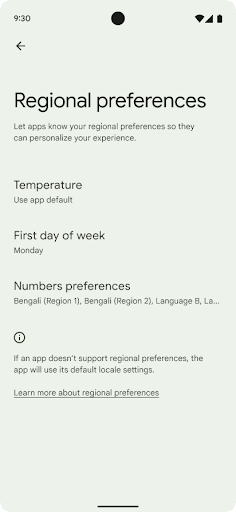

無障礙設定
非線性字型縮放至 200%
自 Android 14 起,系統將支援高達 200% 的字型縮放功能,提供 視力不佳的使用者提供額外的無障礙服務選項, 無障礙內容規範 (WCAG)。
為避免畫面上的大型文字元素縮放過大,系統會採用系統做法 會套用非線性縮放曲線此縮放策略指的是大型文字 因此未像較小的文字一樣縮放非線性字型縮放功能 保留不同大小元素之間的比例階層 減少線性文字縮放為高角度的問題 (例如 截斷或因為超大型顯示而難以閱讀的文字 大小)。
使用非線性字型縮放測試應用程式
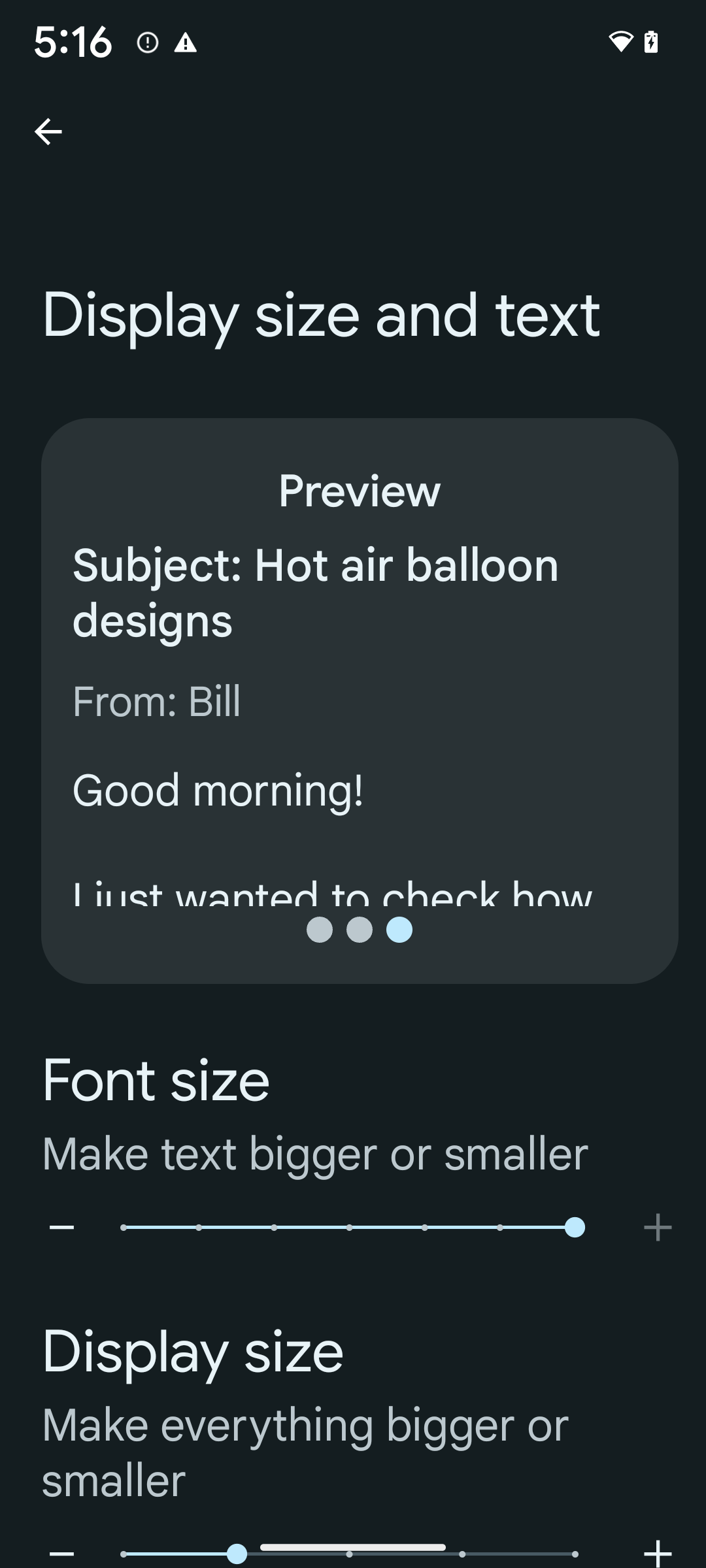
如果您已使用經過調整像素 (sp) 的單位定義文字大小,系統會自動將這些額外選項和縮放改善功能套用至應用程式中的文字。不過,您仍應啟用最大字型大小 (200%) 執行 UI 測試,確保應用程式能正確套用字型大小,並在不影響可用性的情況下,因應更大的字型大小。
如要啟用 200% 的字型大小,請按照下列步驟操作:
- 開啟「設定」應用程式,然後依序前往「無障礙中心」>「無障礙設定」顯示大小和 文字。
- 在「字型大小」選項中,輕觸加號 (+) 圖示,直到達字型大小上限為止,如本節隨附的圖片所示。
使用經過調整像素 (sp) 的單位處理文字大小
請記得一律以 sp 單位為單位指定文字大小。時間 應用程式使用 sp 單位,Android 可套用使用者偏好的文字大小 彈性調整資源配置
請勿使用 sp 單位做為邊框間距,也不應以隱含邊框間距來定義檢視畫面高度: 非線性字型縮放 sp 尺寸比例可能不一致,因此 4sp + 20sp 不一定等於 24sp。
轉換經過調整像素 (sp) 的單位
使用 TypedValue.applyDimension() 將 sp 單位轉換為像素,並使用 TypedValue.deriveDimension() 將像素轉換為 sp。這些方法會自動套用至適當的非線性縮放曲線。
避免使用硬式編碼方程式
Configuration.fontScale 或
DisplayMetrics.scaledDensity。因為字型縮放功能
非線性,scaledDensity 欄位已不準確。由於字型不再以單一標量值進行縮放,因此 fontScale 欄位應僅用於提供資訊。
使用 sp 單位處理 lineHeight
一律改用 sp 單位定義 android:lineHeight
因此,行高會隨著文字縮放。否則,如果您的文字
是 sp,但 lineHeight 的單位為 dp 或 px,則不會縮放,看起來會受到限制。
TextView 會自動修正 lineHeight,使其符合您的預期
只有在 textSize 和 lineHeight 都同時符合時,比例才會保留
以 sp 為單位定義。
相機和媒體
圖片的 Ultra HDR
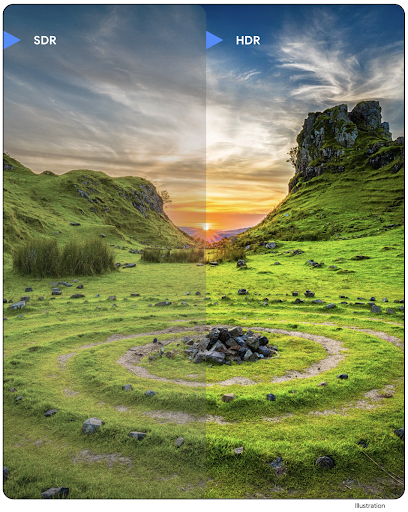
Android 14 adds support for High Dynamic Range (HDR) images that retain more of the information from the sensor when taking a photo, which enables vibrant colors and greater contrast. Android uses the Ultra HDR format, which is fully backward compatible with JPEG images, allowing apps to seamlessly interoperate with HDR images, displaying them in Standard Dynamic Range (SDR) as needed.
Rendering these images in the UI in HDR is done automatically by the framework
when your app opts in to using HDR UI for its Activity Window, either through a
manifest entry or at runtime by calling
Window.setColorMode(). You can also capture compressed Ultra
HDR still images on supported devices. With more colors recovered
from the sensor, editing in post can be more flexible. The
Gainmap associated with Ultra HDR images can be used to render
them using OpenGL or Vulkan.
在相機擴充功能中縮放、對焦、使用後視模式等
Android 14 upgrades and improves camera extensions, allowing apps to handle longer processing times, which enables improved images using compute-intensive algorithms like low-light photography on supported devices. These features give users an even more robust experience when using camera extension capabilities. Examples of these improvements include:
- Dynamic still capture processing latency estimation provides much more
accurate still capture latency estimates based on the current scene and
environment conditions. Call
CameraExtensionSession.getRealtimeStillCaptureLatency()to get aStillCaptureLatencyobject that has two latency estimation methods. ThegetCaptureLatency()method returns the estimated latency betweenonCaptureStartedandonCaptureProcessStarted(), and thegetProcessingLatency()method returns the estimated latency betweenonCaptureProcessStarted()and the final processed frame being available. - Support for capture progress callbacks so that apps can display the current
progress of long-running, still-capture processing operations. You can check
if this feature is available with
CameraExtensionCharacteristics.isCaptureProcessProgressAvailable, and if it is, you implement theonCaptureProcessProgressed()callback, which has the progress (from 0 to 100) passed in as a parameter. Extension specific metadata, such as
CaptureRequest.EXTENSION_STRENGTHfor dialing in the amount of an extension effect, such as the amount of background blur withEXTENSION_BOKEH.Postview Feature for Still Capture in camera extensions, which provides a less-processed image more quickly than the final image. If an extension has increased processing latency, a postview image could be provided as a placeholder to improve UX and switched out later for the final image. You can check if this feature is available with
CameraExtensionCharacteristics.isPostviewAvailable. Then you can pass anOutputConfigurationtoExtensionSessionConfiguration.setPostviewOutputConfiguration.Support for
SurfaceViewallowing for a more optimized and power-efficient preview render path.Support for tap to focus and zoom during extension usage.
感應器內變焦
當 CameraCharacteristics 中的 REQUEST_AVAILABLE_CAPABILITIES_STREAM_USE_CASE 包含 SCALER_AVAILABLE_STREAM_USE_CASES_CROPPED_RAW 時,應用程式可以使用進階感應器功能,透過 CaptureRequest 和 RAW 目標 (其串流用途已設為 CameraMetadata.SCALER_AVAILABLE_STREAM_USE_CASES_CROPPED_RAW),為經裁剪的 RAW 串流提供與全景視野相同的像素。透過實作要求覆寫控制項,更新後的相機可在其他相機控制項準備就緒前,提供縮放控制選項。
無損 USB 音訊
Android 14 支援無損音訊格式,可透過 USB 有線耳機提供頂級音響體驗。您可以查詢 USB 裝置的偏好混合器屬性、註冊偏好混合器屬性變更的事件監聽器,以及使用 AudioMixerAttributes 類別設定混合器屬性。這個類別代表音訊調音器的格式,例如通道遮罩、取樣率和行為。這個類別可讓您直接傳送音訊,不必進行混合、音量調整或處理效果。
開發人員工作效率和工具
Credential Manager
Android 14 adds Credential Manager as a platform API, with additional support back to Android 4.4 (API level 19) devices through a Jetpack Library using Google Play services. Credential Manager aims to make sign-in easier for users with APIs that retrieve and store credentials with user-configured credential providers. Credential Manager supports multiple sign-in methods, including username and password, passkeys, and federated sign-in solutions (such as Sign-in with Google) in a single API.
Passkeys provide many advantages. For example, passkeys are built on industry standards, can work across different operating systems and browser ecosystems, and can be used with both websites and apps.
For more information, see the Credential Manager and passkeys documentation and the blogpost about Credential Manager and passkeys.
Health Connect
Health Connect 是裝置端的使用者健康與健身資料存放區。這項功能可讓使用者在喜愛的應用程式之間分享資料,並透過單一介面控管要與這些應用程式分享的資料。
在 Android 14 以下版本的裝置上,Health Connect 可透過 Google Play 商店下載為應用程式。自 Android 14 起,Health Connect 將成為平台的一部分,並透過 Google Play 系統更新接收更新,無須另外下載。如此一來,Health Connect 就能經常更新,您的應用程式也可以在搭載 Android 14 以上版本的裝置上使用 Health Connect。使用者可以透過裝置的「設定」存取 Health Connect,系統設定中已整合隱私權控制選項。


Health Connect 在 Android 14 中提供多項新功能,例如運動路線,可讓使用者分享健身路線,並在地圖上顯示。路線的定義是指在一段時間內儲存的地點清單,應用程式可將路線插入運動時段,將路線連結在一起。為確保使用者能完全控管這類私密資料,使用者必須允許與其他應用程式共用個別路線。
詳情請參閱 Health Connect 說明文件和「Android 健康資料新功能」一文。
OpenJDK 17 更新
Android 14 continues the work of refreshing Android's core libraries to align with the features in the latest OpenJDK LTS releases, including both library updates and Java 17 language support for app and platform developers.
The following features and improvements are included:
- Updated approximately 300
java.baseclasses to Java 17 support. - Text Blocks, which introduce multi-line string literals to the Java programming language.
- Pattern Matching for instanceof, which allows an object to
be treated as having a specific type in an
instanceofwithout any additional variables. - Sealed classes, which allow you restrict which classes and interfaces can extend or implement them.
Thanks to Google Play system updates (Project Mainline), over 600 million devices are enabled to receive the latest Android Runtime (ART) updates that include these changes. This is part of our commitment to give apps a more consistent, secure environment across devices, and to deliver new features and capabilities to users independent of platform releases.
Java and OpenJDK are trademarks or registered trademarks of Oracle and/or its affiliates.
應用程式商店改善項目
Android 14 introduces several PackageInstaller APIs that
allow app stores to improve their user experience.
Request install approval before downloading
Installing or updating an app might require user approval.
For example, when an installer making use of the
REQUEST_INSTALL_PACKAGES permission attempts to install a
new app. In prior Android versions, app stores can only request user approval
after APKs are written to the install session and the
session is committed.
Starting with Android 14, the requestUserPreapproval()
method lets installers request user approval before committing the install
session. This improvement lets an app store defer downloading any APKs until
after the installation has been approved by the user. Furthermore, once a user
has approved installation, the app store can download and install the app in the
background without interrupting the user.
Claim responsibility for future updates
The setRequestUpdateOwnership() method allows an installer
to indicate to the system that it intends to be responsible for future updates
to an app it is installing. This capability enables update ownership
enforcement, meaning that only the update owner is permitted
to install automatic updates to the app. Update ownership enforcement helps to
ensure that users receive updates only from the expected app store.
Any other installer, including those making use of the
INSTALL_PACKAGES permission, must receive explicit user
approval in order to install an update. If a user decides to proceed with an
update from another source, update ownership is lost.
Update apps at less-disruptive times
App stores typically want to avoid updating an app that is actively in use because this leads to the app's running processes being killed, which potentially interrupts what the user was doing.
Starting with Android 14, the InstallConstraints API
gives installers a way to ensure that their app updates happen at an opportune
moment. For example, an app store can call the
commitSessionAfterInstallConstraintsAreMet() method to
make sure that an update is only committed when the user is no longer
interacting with the app in question.
Seamlessly install optional splits
With split APKs, features of an app can be delivered in separate APK files,
rather than as a monolithic APK. Split APKs allow app stores to optimize the
delivery of different app components. For example, app stores might optimize
based on the properties of the target device. The
PackageInstaller API has supported splits since its
introduction in API level 22.
In Android 14, the setDontKillApp() method allows an
installer to indicate that the app's running processes shouldn't be killed when
new splits are installed. App stores can use this feature to seamlessly install
new features of an app while the user is using the app.
應用程式中繼資料套件
從 Android 14 開始,Android 套件安裝程式可讓您指定應用程式中繼資料 (例如資料安全性做法),以加入 Google Play 等應用程式商店頁面。
在使用者擷取裝置螢幕畫面時偵測
為建立更標準化的螢幕截圖偵測體驗,Android 14 推出了具隱私保護功能的螢幕截圖偵測 API。此 API 可讓應用程式依個別活動登錄回呼。當使用者在具備瀏覽權限的活動中拍攝螢幕截圖時,系統會叫用這些回呼,並傳送通知給使用者。
使用者體驗
Sharesheet 自訂動作與改善排名
Android 14 updates the system sharesheet to support custom app actions and more informative preview results for users.
Add custom actions
With Android 14, your app can add custom actions to the system sharesheet it invokes.
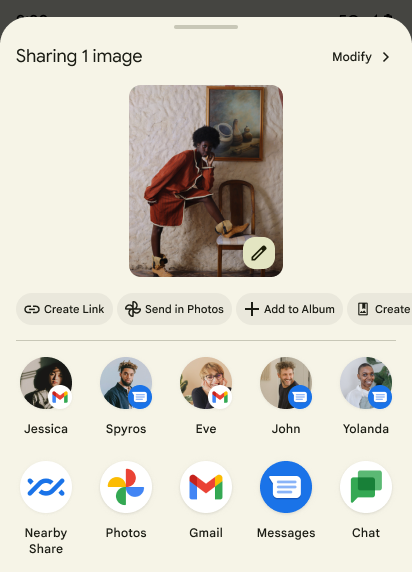
Improve ranking of Direct Share targets
Android 14 uses more signals from apps to determine the ranking of the direct share targets to provide more helpful results for the user. To provide the most useful signal for ranking, follow the guidance for improving rankings of your Direct Share targets. Communication apps can also report shortcut usage for outgoing and incoming messages.
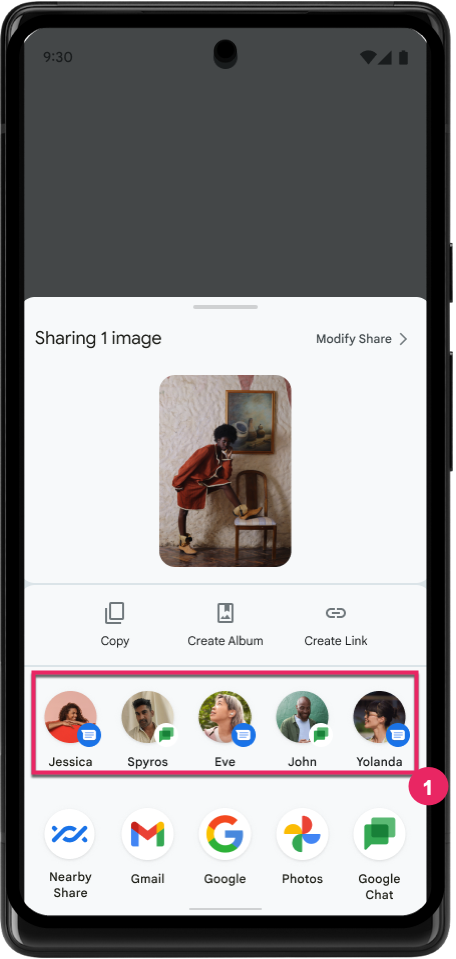
支援預測返回功能的內建和自訂動畫
Android 13 推出了在開發人員選項背後顯示「預測返回主畫面」動畫的功能。只要使用支援的應用程式,並啟用開發人員選項,當您執行滑動返回的操作時,系統就會顯示動畫,指出返回手勢可讓應用程式結束並返回主畫面。
Android 14 內含多項改善項目,並提供有關預測返回手勢的全新指南:
- 您可以設定
android:enableOnBackInvokedCallback=true,選擇針對個別活動啟用預測返回系統動畫,而非針對整個應用程式。 - 我們新增了系統動畫,以配合 Android 13 的「返回主畫面」動畫。新的系統動畫具有跨活動和跨工作的特色,您只要改用預測返回功能,即可自動取得。
- 我們為底部功能表、側邊功能表和搜尋頁面新增了 Material 元件動畫。
- 我們製作了設計指南,讓您瞭解如何建立自訂的應用程式內動畫和轉場效果。
- 我們新增了 API,支援自訂的應用程式內轉換動畫:
在這個 Android 14 預先發布版本中,所有預測返回相關功能都保留在開發人員選項後方。請參閱開發人員指南,瞭解如何讓應用程式改用預測返回功能,以及如何建立自訂的應用程式內轉場效果。
大螢幕裝置製造商個別應用程式覆寫值
個別應用程式覆寫值可讓裝置製造商變更大螢幕裝置上的應用程式行為。舉例來說,即使應用程式資訊清單中已設定 resizeableActivity="false",FORCE_RESIZE_APP 覆寫值仍會指示系統根據螢幕尺寸調整應用程式大小 (避免大小相容性模式)。
覆寫設定的用意是改善大螢幕的使用者體驗。
新的資訊清單屬性可讓您為應用程式停用部分裝置製造商覆寫值。
大螢幕使用者個別應用程式覆寫值
Per-app overrides change the behavior of apps on large screen devices. For example, the OVERRIDE_MIN_ASPECT_RATIO_LARGE device manufacturer override sets the app aspect ratio to 16:9 regardless of the app's configuration.
Android 14 QPR1 enables users to apply per‑app overrides by means of a new settings menu on large screen devices.
應用程式分享螢幕畫面
分享應用程式畫面功能可讓使用者在錄製螢幕內容時,分享應用程式視窗,而非整個裝置畫面。
透過應用程式螢幕分享功能,系統會從共用畫面中排除狀態列、導覽列、通知和其他系統 UI 元素。只會分享所選應用程式的內容。
應用程式螢幕分享功能可讓使用者執行多個應用程式,但只分享單一應用程式的內容,進而提升工作效率和隱私權。
Pixel 8 Pro 上的 Gboard 智慧回覆功能 (由 LLM 支援)
On Pixel 8 Pro devices with the December Feature Drop, developers can try out higher-quality smart replies in Gboard powered by on-device Large Language Models (LLMs) running on Google Tensor.
This feature is available as a limited preview for US English in WhatsApp, Line, and KakaoTalk. It requires using a Pixel 8 Pro device with Gboard as your keyboard.
To try it out, first enable the feature in Settings > Developer Options > AiCore Settings > Enable Aicore Persistent.
Next, open a conversation in a supported app to see LLM-powered Smart Reply in Gboard's suggestion strip in response to incoming messages.
圖形
路徑可供查詢及內插
Android's Path API is a powerful and flexible mechanism for
creating and rendering vector graphics, with the ability to stroke or fill a
path, construct a path from line segments or quadratic or cubic curves, perform
boolean operations to get even more complex shapes, or all of these
simultaneously. One limitation is the ability to find out what is actually in a
Path object; the internals of the object are opaque to callers after creation.
To create a Path, you call methods such as
moveTo(), lineTo(), and
cubicTo() to add path segments. But there has been no way to
ask that path what the segments are, so you must retain that information at
creation time.
Starting in Android 14, you can query paths to find out what's inside of them.
First, you need to get a PathIterator object using the
Path.getPathIterator API:
Kotlin
val path = Path().apply { moveTo(1.0f, 1.0f) lineTo(2.0f, 2.0f) close() } val pathIterator = path.pathIterator
Java
Path path = new Path(); path.moveTo(1.0F, 1.0F); path.lineTo(2.0F, 2.0F); path.close(); PathIterator pathIterator = path.getPathIterator();
Next, you can call PathIterator to iterate through the segments
one by one, retrieving all of the necessary data for each segment. This example
uses PathIterator.Segment objects, which packages up the data
for you:
Kotlin
for (segment in pathIterator) { println("segment: ${segment.verb}, ${segment.points}") }
Java
while (pathIterator.hasNext()) { PathIterator.Segment segment = pathIterator.next(); Log.i(LOG_TAG, "segment: " + segment.getVerb() + ", " + segment.getPoints()); }
PathIterator also has a non-allocating version of next() where you can pass
in a buffer to hold the point data.
One of the important use cases of querying Path data is interpolation. For
example, you might want to animate (or morph) between two different paths. To
further simplify that use case, Android 14 also includes the
interpolate() method on Path. Assuming the two paths have
the same internal structure, the interpolate() method creates a new Path
with that interpolated result. This example returns a path whose shape is
halfway (a linear interpolation of .5) between path and otherPath:
Kotlin
val interpolatedResult = Path() if (path.isInterpolatable(otherPath)) { path.interpolate(otherPath, .5f, interpolatedResult) }
Java
Path interpolatedResult = new Path(); if (path.isInterpolatable(otherPath)) { path.interpolate(otherPath, 0.5F, interpolatedResult); }
The Jetpack graphics-path library enables similar APIs for earlier versions of Android as well.
使用頂點和片段著色器的自訂網格
Android 一直支援使用自訂著色繪製三角形網格,但輸入網格格式僅限於少數預先定義的屬性組合。Android 14 新增了自訂網格支援功能,可將其定義為 三角形 或 三角形條,並視需要編入索引。這些網格會使用自訂屬性、頂點步幅、變化,以及以 AGSL 編寫的頂點和片段著色器指定。
頂點著色器會定義變化,例如位置和顏色,而片段著色器則可選擇定義像素的顏色,通常是使用頂點著色器建立的變化。如果片段著色器提供顏色,系統會使用繪製網格時選取的混合模式,將該顏色與目前的 Paint 顏色混合。統一變數可傳遞至片段和頂點著色器,以提供更多彈性。
Canvas 的硬體緩衝區轉譯器
為協助使用 Android 的 Canvas API 以硬體加速繪製至 HardwareBuffer,Android 14 推出了 HardwareBufferRenderer。如果您的用途涉及透過 SurfaceControl 與系統合成器通訊,以便繪製低延遲畫面,這個 API 就特別實用。

